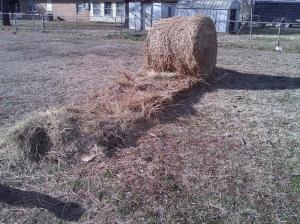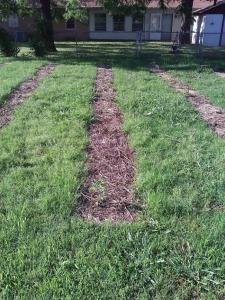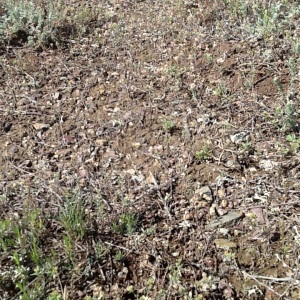I’m excited to present to my awesome readers a new type of blog post.
You guys know I’m always up for learning new things, and those of you who know me personally also know that sometimes I find a topic I find exceptionally fascinating and then follows a million or two questions. I know it can be really annoying endearing.
…and the point of this bloggety-blog is to pass on good, clever, life-changing information. One aspect of my 4-acre corner of the world that drives me a little crazy is the soil condition. I’m gonna be honest, the soil we have been blessed with is pretty dismal. I’m not sure much can grow on it without a lot — and I mean a heck of a lot — of love. My husband tells a story of a rancher waaaaaaaay back in the day who was offered acres upon acres of land in this area for purchase at a very low price. After coming out to look at the land, he kindly refused to purchase any part of it, saying, “Nothing grew out there, even the jackrabbit was packing his own lunch.”
I have been researching and trying to figure out how we could possibly tend to the soil we have in order to improve it, and although there are various methods out there, I know we have our work cut out for us.
So, without further ado, I am happy to introduce our first ever Merrill Family Farm guest “speaker,” Scott Strough.
**APPLAUSE**
((PLEASE NOTE: At the end of this blog post, you’ll have an opportunity to vote for Scott to move forward with a grant proposal. It only takes a second to Vote and it doesn’t cost a thing. If you find that you don’t have time to read through the entire post today, just take a moment to Vote . Ok, back to the guest speaker))
Hi Scott, tell us a little about yourself.
I was born in Florida, but my Dad always dreamed of eventually buying a farm and homesteading. Once he even looked at Alaska as a possibility, but decided it was a bit too far from civilization considering 4 very young children. He did however intern for a while on a farm. Mom grew up on a farm in North Carolina, so between them I gained lots of knowledge and country wisdom. Although my Dad never got the farm he dreamed of, he was able to eventually buy a three acre mini homestead in Indiana with all the barns and outbuildings. We raised beef cows, a milk goat, chickens, geese, a pony, rabbits, a 1/2 acre garden, a small orchard, a few grape vines, raspberries, strawberries, asparagus. For three acres it was very, very productive. Unbelievable how much food can be produced on small acreage. Me and my siblings were active in 4H and all of us worked for the bigger commercial farms and seed companies in summer. So I got a good idea of agriculture both small scale organic and commercial scale at an early age. It is also when I discovered how much better homegrown vegetables taste. You simply can’t beat a homegrown heirloom tomato, especially in those rich Indiana soils! WOW I am semi-retired now, but I also have the same dream my father had, to become self sufficient on a farm. Seems my little market garden is in dire danger of expanding into a full fledged farm! I guess the apple really doesn’t fall far from the tree. 
It’s good to know you’ve got a good solid background in homesteading. Let’s talk about permaculture a bit. What the heck is it, anyway?
“Permaculture is a philosophy of working with, rather than against nature; of protracted & thoughtful observation rather than protracted & thoughtless labor; and of looking at plants and animals in all their functions, rather than treating any area as a single-product system.” Bill Mollison
I can’t say it any better than Bill Mollison did.
Beautiful! So keeping in mind what permaculture is, what are the ideas behind how we can improve soil conditions?
The five keys to building soil health are:
1) Least amount of mechanical disturbance possible (no till)
2) Armor on the soil (either living plants and/or mulches, no bare soil ever)
3) Diversity (both plant and animal biodiversity)
4) Living root in the ground as long as possible (to provide habitat for beneficial soil microbiology)
5) Animal impact (but rotated so there is neither over grazing nor undergrazing)
Can you explain in a sentence or two each of the points above?
I really can’t. That is already the short version. The details will take an hour to explain. However, for those with an hour to spare, a farmer friend of mine with whom I consult and share information has made a presentation. Gabe Brown: Keys To Building a Healthy Soil
YES! Ways to dig deeper and learn more things! Can’t wait to look at the presentation!
Tell me a little bit about what rotational grazing is and how it can be used to improve soil conditions.
One of the most exciting new breakthroughs in animal husbandry is the various forms of Managed Intensive Rotational Grazing. The basic concept is to more closely mimic the way native wild herds and flocks of animals coevolved with various biomes. The idea is to use animal impact to harvest forage, and then rest the area long enough for vigorous regrowth. The manure provided by the animals speeds this regrowth if the plants are not overgrazed initially. This results in 400%, 500% or more increases in total biomass yields. If you over graze, the plants need to start all over again from the beginning as babies that start out growing slow. If you under graze, plants stop growing and instead go to seed. So by taking less to begin with, the forage recovers much faster. You never want that animal to take a “second bite” from the same plant until it has recovered fully. Then all you do is graze before growth stops and it goes to seed. Then you take the animals completely off the area, allowing the partially grazed plants to regrow. This mimics the native herds’ or flocks’ migrations. This keeps the forage in optimum growth stage all season.
What is the timeframe where you can see positive changes in the soil?
I generally see improvements within weeks. The worms get to work almost immediately and they breed very fast when there is plentiful food and adequate moisture. All those worm castings end up supplying your crops all the fertilizer they need throughout the growing season. It takes a few years though before long term soil carbon increases are significant. But you do see steady improvement every year. In fact it is an accelerating growth curve. As soil health increases, the rate of regeneration increases even more. Within 3-4 years you should have dramatic improvements across the board.
I don’t mean to be rude, but all that is good in theory. How do you accomplish this in the real world?
I started small, only 1/10th of an acre. I did this to prove with working trials the concept works. Unlike the better proven food forest styles of permaculture, not much has been done with the grassland/savanna biomes. Here in Central Oklahoma the top successional biome isn’t forest, it’s a tall grass prairie / oak savanna. But to mimic that biome with annual vegetable crops had never been done to scale. So I first developed a way to sheet mulch large scale quickly and with low labor. I first mow to ~ 4 inches. Then I use the “second bite principle” in reverse. In narrow rows I mow again right down flush to the ground exactly 5 days later. Between the rows I don’t mow. This “stunts” the growth of the grass in narrow bands where I will plant my tomatoes peppers etc. Next I roll out a sheet of recycled paper and cover it with mulch. Commercial rolls can be had very cheap. You can even buy round bales of hay and unroll them right over the paper quickly. Next I simply make small holes for my transplants right through the paper and mulch. I generally also add mycorrhizal fungi inoculant to the transplants and compost just in the transplant hole. This gets the soil biology working for the plants right from the start. Instead of weeding I simply keep between the rows mowed. Each time I mow it fertilizes the crop! At full scale many of the mowing passes, particularly at the beginning and end of the season, can be grazed instead of using a brush hog or mower. This give you stacking productivity on the same land same season. The reason this is scalable is because commercial rolls of paper can come in lengths of 1000 feet or more. Huge round bales of hay already have equipment designed to unroll them. It doesn’t have to necessarily be done by hand. On small areas I do it by hand, but all I need is the equipment and it can be scaled however large I need. That’s the purpose of the grant I applied for. I leased an old abandoned “farmed out” piece of property in exchange for regenerating this old farm back to fertility and productivity. Now all I need is the equipment to prove what has already worked small scale can work scaled up.
This is really exciting! Do you have a picture of your field?
Sure! Here are two pictures, but for more info, you can click here to read more about the project.


I’m going to be a little selfish and ask a question that pertains to the state of my soil. I don’t have hardly any prairie grass growing. It’s a few sagebrush and some little insignificant plants that grow close to the ground. Can your idea still work in my area?
This is what my poor excuse of soil looks like. This is in the pasture area, after heavy rains (which is why it looks a little moist). Otherwise, it’s normally very, very dusty.
Yes. Absolutely. The main limiting factors are length of growing season and effective moisture. Since carbon in the form of humus acts like a sponge for moisture, as it increases the little moisture you get will be used more effectively. Might be slow going to begin with, but over time positive benefits will accelerate. You might have to irrigate a little to jump start the system especially in drought years, but eventually you should be able to decrease irrigation dramatically. Maybe even eliminate it completely. It all depends on your local conditions and the crops you decide to grow. It takes surprisingly little rain to work the system, but obviously the speed of recovery is largely dependant on water.
So you’re essentially taking a large piece of property (20 or so acres) that has been “farmed out” by conventional farming practices that have left the soil barren, and turning it into a thriving organism, capable of producing garden vegetables? That’s really inspiring!! Where do we go from here?
I now have an awesome opportunity to grow this idea to the next level in size, maybe with a generous grant from Chase to buy the farming equipment needed for a larger scale. There are a few abandoned farms directly adjacent to my market garden. One of them has traded a lease for me restoring the productivity of his farm and soil health. But it is about 40 acres and all is in terrible shape, incredibly poor soil and erosion and scrub. Completely unfit for agriculture and slowly deteriorating away. I know permaculture can regenerate this land and have already started on 1/2 acre. It will take a lot of money for equipment and hard work to get most that 40 acres productive again, but for sure permaculture methods are the way to go. The farm is too far gone to even try conventional methods. Long ago “farmed out” and due to Oklahoma weather patterns (flood or drought with little in between) it has actually deteriorated even worse since going fallow. I am excited to say I applied for a Chase small business grant. The next step in the process is to obtain 250 votes from people who would like to see my tiny farm grow to the next level. If I am accepted, I will use the grant money to purchase the labor saving equipment required to reach a moderate scale. This will allow me to prove the organic permaculture methods I am using to restore soil health work at scale. I also should be able to integrate carefully controlled modern animal husbandry in a Savory type Holistic managed planned grazing rotation with my veggies. Once I get 250 votes (it’s free to vote so please help), then my application goes to the final step, the review process. The grant is for $100,000! That will allow me all the farm equipment I need to really get this truck farm operating in high gear! (all no till) I already have the landowner that is leasing me the land in exchange for clearing and regenerating soil health on board! So this could potentially be a huge break! I could potentially jump to 20 acres and even get the greenhouse I need all in 1 year!
Any of you guys that feel what I am doing is interesting or important, please help out with a vote!
Vote here: Vote !
If I should happen to get this grant and get this abandoned farm back into production, I intend to sink the profits from the farm into buying another adjacent abandoned farm of 58 acres. Maybe even a third abandoned farm also adjacent with 20 acres and an abandoned old concrete block building that was once a vegetable stand decades ago! Then I will start up an apprenticeship program to teach new young novice farmers the principles of permaculture and how to start their own farms from the bottom up. This will be just one more link in the growing conversion of agriculture worldwide! Thanks again.
Thank you for your time, Scott, and for answering my million questions.
Ok, my sweet readers, please take a moment to click on the voting link above (or below), and add your vote for Mr. Scott! One little click can change a small corner of the world 🙂 It’s super easy, even I was able to do it 🙂 And, if there are other members in your house that are also Facebook users, please have them vote, too!
One final word from Scott on why you can only vote through Facebook:
Apparently Chase uses Facebook to try and make sure people only vote once. My business is a roadside tomato stand and by the time my customers start stopping by for tomatoes, the time limit for voting will be up. It’s very frustrating. I know my customers would for sure vote, but I don’t have any ripe tomatoes yet!
Ready, set, cast your VOTE!






Thanks to your support I made it to the judging phase of the Mission Main Street Grants program from Chase! I am in the running for a $100,000 grant which I will use to buy equipment to expand my small market farm. Recipients will be announced in September – wish me luck!
LikeLiked by 1 person
We’re so glad to have been part of it! Please keep us posted on the September results!
LikeLike
Sorry it took so long to reply. I didn’t get the grant so I am scrambling to find alternatives for next year. I want to thank all who voted though.
LikeLike